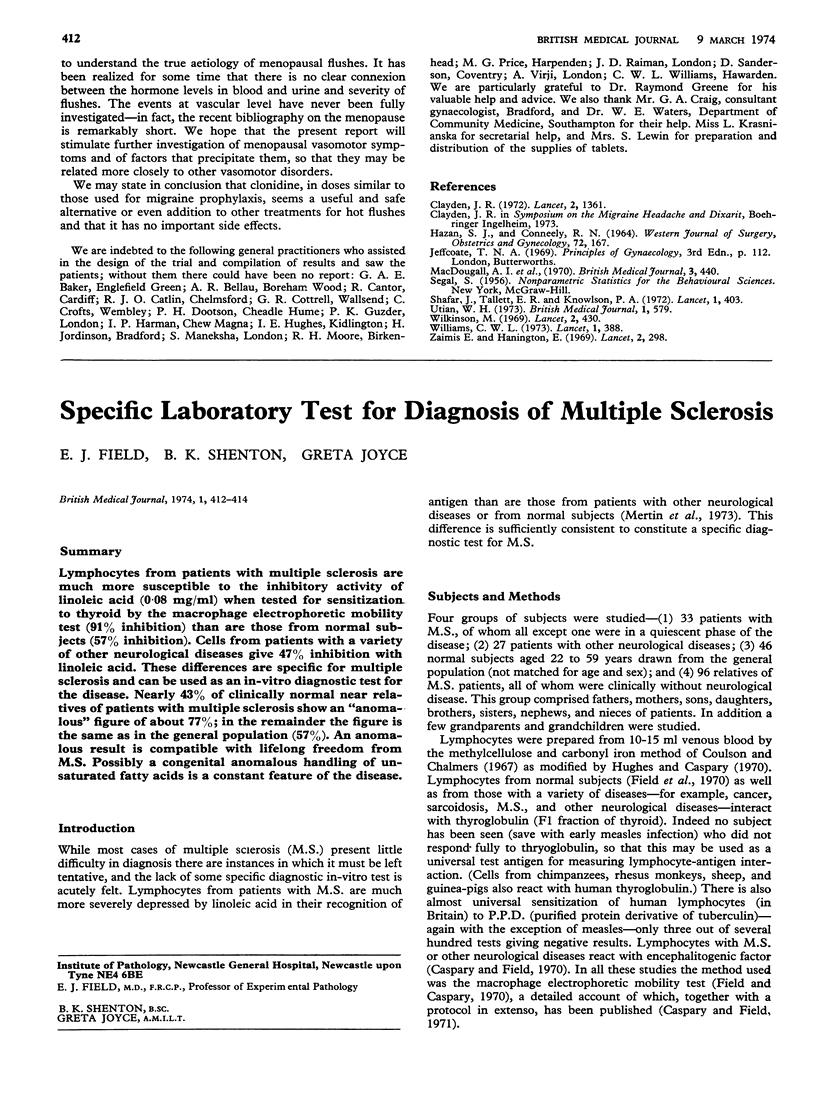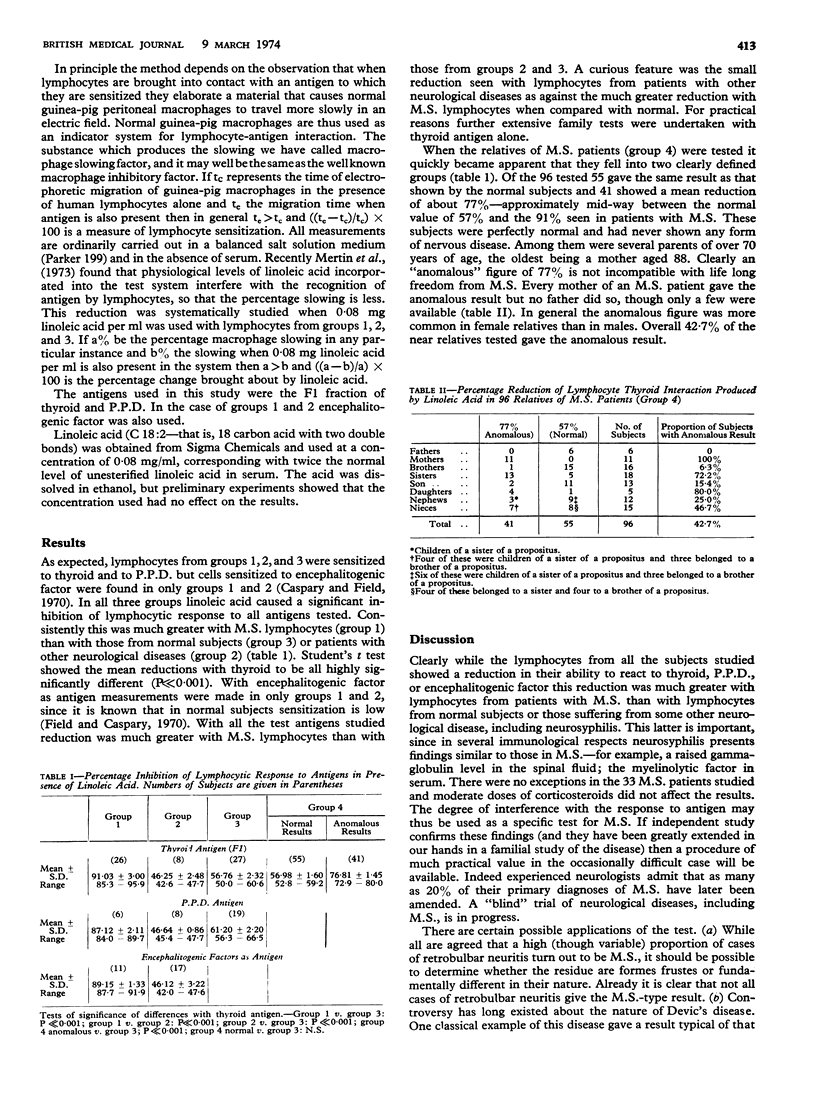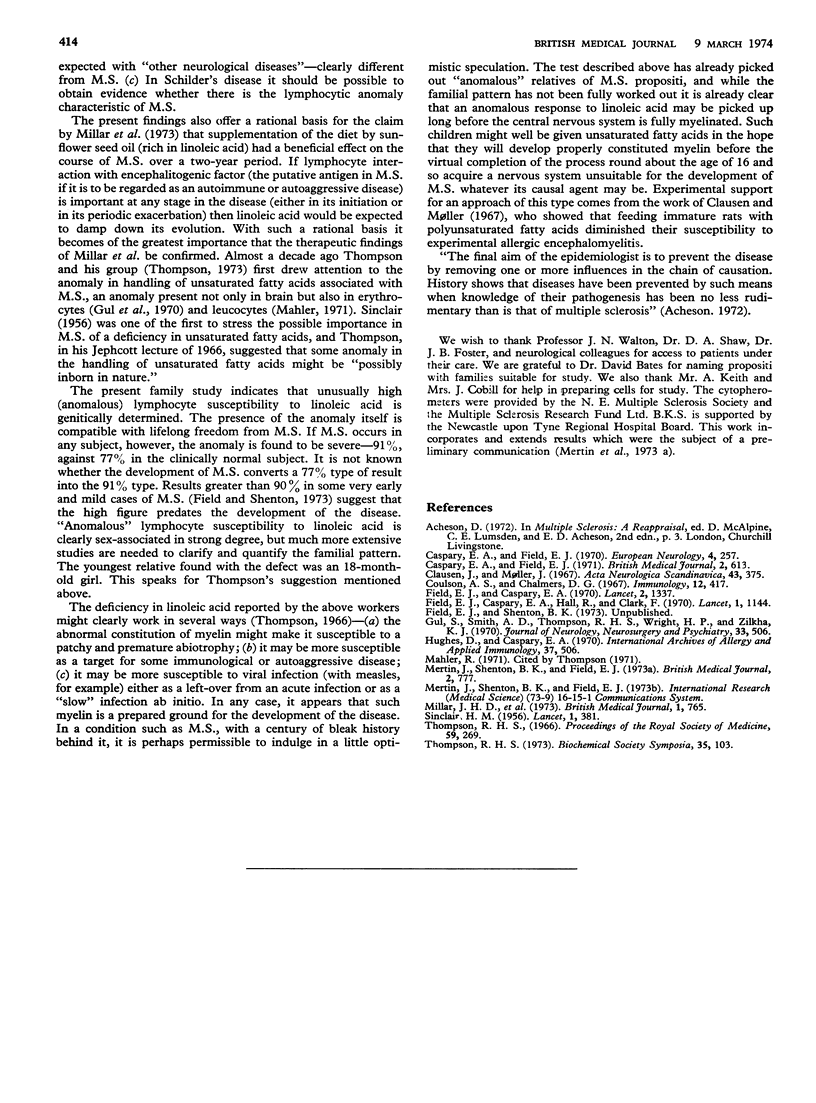Abstract
Lymphocytes from patients with multiple sclerosis are much more susceptible to the inhibitory activity of linoleic acid (0·08 mg/ml) when tested for sensitization to thyroid by the macrophage electrophoretic mobility test (91% inhibition) than are those from normal subjects (57% inhibition). Cells from patients with a variety of other neurological diseases give 47% inhibition with linoleic acid. These differences are specific for multiple sclerosis and can be used as an in-vitro diagnostic test for the disease. Nearly 43% of clinically normal near relatives of patients with multiple sclerosis show an “anomalous” figure of about 77%; in the remainder the figure is the same as in the general population (57%). An anomalous result is compatible with lifelong freedom from M.S. Possibly a congenital anomalous handling of unsaturated fatty acids is a constant feature of the disease.
Full text
PDF


Selected References
These references are in PubMed. This may not be the complete list of references from this article.
- Caspary E. A., Field E. J. Sensitization of blood lymphocytes to possible antigens in neurological disease. Eur Neurol. 1970;4(5):257–266. doi: 10.1159/000114027. [DOI] [PubMed] [Google Scholar]
- Caspary E. A., Field E. J. Specific lymphocyte sensitization in cancer: is there a common antigen in human malignant neoplasia? Br Med J. 1971 Jun 12;2(5762):613–617. doi: 10.1136/bmj.2.5762.613. [DOI] [PMC free article] [PubMed] [Google Scholar]
- Clausen J., Moller J. Allergic encephalomyelitis induced by brain antigen after deficiency in polyunsaturated fatty acids during myelination. Is multiple sclerosis a nutritive disorder? Acta Neurol Scand. 1967;43(3):375–388. doi: 10.1111/j.1600-0404.1967.tb05740.x. [DOI] [PubMed] [Google Scholar]
- Coulson A. S., Chalmers D. G. Response of human blood lymphocytes to tuberculin PPD in tissue culture. Immunology. 1967 Apr;12(4):417–429. [PMC free article] [PubMed] [Google Scholar]
- Field E. J., Caspary E. A., Hall R., Clark F. Circulating sensitised lymphocytes in Graves' disease. Observations on its pathogenesis. Lancet. 1970 May 30;1(7657):1144–1147. doi: 10.1016/s0140-6736(70)91217-1. [DOI] [PubMed] [Google Scholar]
- Field E. J., Caspary E. A. Lymphocyte sensitisation: an in-vitro test for cancer? Lancet. 1970 Dec 26;2(7687):1337–1341. doi: 10.1016/s0140-6736(70)92361-5. [DOI] [PubMed] [Google Scholar]
- Gul S., Smith A. D., Thompson R. H., Wright H. P., Zilkha K. J. Fatty acid composition of phospholipids from platelets and erythrocytes in multiple sclerosis. J Neurol Neurosurg Psychiatry. 1970 Aug;33(4):506–510. doi: 10.1136/jnnp.33.4.506. [DOI] [PMC free article] [PubMed] [Google Scholar]
- Hughes D., Caspary E. A. Lymphocyte transformation in vitro measured by tritiated thymidine uptake. I. Lymphocyte culture techniques. Int Arch Allergy Appl Immunol. 1970;37(5):506–531. doi: 10.1159/000230240. [DOI] [PubMed] [Google Scholar]
- Mertin J., Shenton B. K., Field E. J. Unsaturated fatty acids in multiple sclerosis. Br Med J. 1973 Jun 30;2(5869):777–778. doi: 10.1136/bmj.2.5869.777-b. [DOI] [PMC free article] [PubMed] [Google Scholar]
- Millar J. H., Zilkha K. J., Langman M. J., Wright H. P., Smith A. D., Belin J., Thompson R. H. Double-blind trial of linoleate supplementation of the diet in multiple sclerosis. Br Med J. 1973 Mar 31;1(5856):765–768. doi: 10.1136/bmj.1.5856.765. [DOI] [PMC free article] [PubMed] [Google Scholar]
- SINCLAIR H. M. Deficiency of essential fatty acids and atherosclerosis, etcetera. Lancet. 1956 Apr 7;270(6919):381–383. [PubMed] [Google Scholar]


